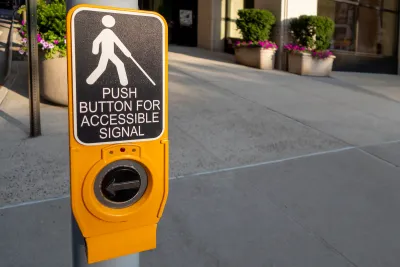Some critics of car-free zones call them exclusionary to people with disabilities, but other experts argue that, when properly planned, pedestrian enhancements improve safety and accessibility for everyone.

In a piece for Mother Jones, Julia Métraux explains how accessibility is being used as a “political football” to push back against car-free zones and other pedestrian infrastructure that some say harms mobility for disabled people. “Opponents of such initiatives have called them ‘exclusionary,’ ‘not progressive or inclusive,’ and bound to ‘hurt people with disabilities,’ pointing out that many disabled people simply need cars to get around.”
Yet disabled people are more likely not to drive, and car-heavy cities are more dangerous to disabled people, says expert Anna Zivarts. “A 2015 study by Georgetown University researchers found that the rate of vehicle-pedestrian deaths among wheelchair users was 36% higher than that of the overall population.”
Even when accessibility is an issue, it’s often easily solved. “In 2022, when San Francisco’s Golden Gate Park permanently closed a major boulevard to cars, opponents, including city Supervisor Connie Chan, said it was disabled and aging folks who would pay the price. But free shuttles, accessible to anyone, now bridge the gap.”
San Francisco also maintains a dialogue with disabled residents to ensure its programs serve them. When the city was evaluating its scooter sharing program, feedback from a group of students with disabilities helped the city opt for scooters with backrests and larger wheels for stability to ensure more people can ride them.
FULL STORY: Do Car-Free Zones Hurt Disabled People? Experts Explain.

National Parks Layoffs Will Cause Communities to Lose Billions
Thousands of essential park workers were laid off this week, just before the busy spring break season.

Retro-silient?: America’s First “Eco-burb,” The Woodlands Turns 50
A master-planned community north of Houston offers lessons on green infrastructure and resilient design, but falls short of its founder’s lofty affordability and walkability goals.

Delivering for America Plan Will Downgrade Mail Service in at Least 49.5 Percent of Zip Codes
Republican and Democrat lawmakers criticize the plan for its disproportionate negative impact on rural communities.

Test News Post 1
This is a summary

Test News Headline 46
Test for the image on the front page.

Balancing Bombs and Butterflies: How the National Guard Protects a Rare Species
The National Guard at Fort Indiantown Gap uses GIS technology and land management strategies to balance military training with conservation efforts, ensuring the survival of the rare eastern regal fritillary butterfly.
Urban Design for Planners 1: Software Tools
This six-course series explores essential urban design concepts using open source software and equips planners with the tools they need to participate fully in the urban design process.
Planning for Universal Design
Learn the tools for implementing Universal Design in planning regulations.
EMC Planning Group, Inc.
Planetizen
Planetizen
Mpact (formerly Rail~Volution)
Great Falls Development Authority, Inc.
HUDs Office of Policy Development and Research
NYU Wagner Graduate School of Public Service




























